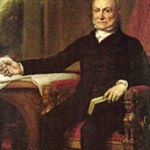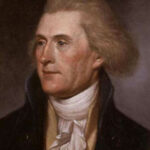James Madison was the fourth President of the United States serving in office from 1809 to 1817. He is remembered as the “Father of the Constitution,” because of the key role he played in the creation of the United States Constitution. Working closely with Thomas Jefferson, Madison also created the Democratic-Republican Party in the 1790’s, and as Jefferson’s Secretary of State, handled the Louisiana Purchase, (doubling the nation’s size). (1)
Born in Port Conway, Virginia on March 16, 1751, Madison was the eldest of twelve siblings, seven of whom reached adulthood. His parents, Colonel James Madison, Sr. and Eleanor Rose Conway were slave owners and managed a tobacco plantation in Orange County, Virginia. Madison left his parent’s plantation at the age of 18 to attend the College of New Jersey (which later became known as Princeton University), finishing a four-year course in half the time. Although he exhausted himself from overwork, he soon regained his health, and began his forty-one year political career in December of 1774, when he got appointed to the Orange County Committee of Safety. (1)
In May of 1787, James Madison traveled to Philadelphia to attend the Constitutional Convention. It was Madison’s dedication and hard work at the convention helped greatly in the drafting of the Constitution, and earned him the title as the “Father of the Constitution” by the age of 36. Madison, however, protested that the document was not “the off-spring of a single brain,” but rather “the work of many heads and many hands.” (2)
James Madison and the other delegates to the Constitutional Convention met in Philadelphia, intending to amend the Articles of Confederation, however, they ended up creating a new constitution altogether. Representing Virginia, Madison took on the job as chief recorder of information, and wrote out pages of notes on what was discussed at the convention. Madison’s previous experience in developing Virginia’s Constitution (eleven years earlier) made the process of drafting a new constitution easier, as his Virginia Plan served as the basis for debate. (3)
Madison was the most prepared member at the convention and contributed more than anyone else to the framing of the Constitution. Madison stood firm in his demands for a strong central government (which would unify the country) and in his belief that the small states needed to give up their equal representation in Congress. Madison also believed that an executive power (or president) needed to be able to defend himself against improper interference by the legislature, and that his election should be through an Electoral College. After meeting secretly throughout the summer of 1787, the proposed Constitution was finally signed on September 17. (4)
Since two-thirds of the 13 states had to ratify the Constitution in order for it to become the law by which all Americans abided, it was sent to each state on September 28. Madison campaigned for the ratification of the Constitution by co-authoring a series of essays, (known as The Federalist Papers), with John Jay and Alexander Hamilton. All 85 of these essays, (29 of which were written by Madison) appeared in various New York newspapers that quickly circulated around the other 12 states. (3)
On June 21, 1788, New Hampshire became the ninth state to ratify the new Constitution, allowing it to become the “universal” law of the land. Once the Constitution went into effect, it was criticized for lacking a Bill of Rights (or amendments) to protect each citizen’s rights. Madison recognized that the drafting of a Bill of Rights was essential, as some states ratified the Constitution based on the expectation that these amendments would be made. (3)
In 1789, as a member of the newly created U.S. House of Representatives, James Madison introduced the first amendments (now known as the Bill of Rights) to the Constitution. Madison originally drafted nineteen amendments, out of which his congressional colleagues passed twelve on to the states for ratification. On December 15, 1791, ten amendments were ratified by enough states to become part of the Constitution. These amendments guaranteed individual rights, such as the freedom of speech, religion, and the press. (5)
In 1817, James Madison’s second term as president ended and he and Dolley retired to Montpelier. Madison founded the American Colonization Society dedicated to freeing slaves and transporting them to the West Coast of Africa. Madison briefly came out of retirement at the age of 79 to attend the 1829 Virginia Constitutional Convention. Even in retirement, Madison stayed active in politics and worried about how the Federal Union was in danger of being shattered. In a note opened after his death in 1836, Madison said, “The advice nearest to my heart and deepest in my convictions is that the Union of the States be cherished and perpetuated.” (2)
1. Wikipedia. James Madison. 12 Sept. 2006. 13 Sept. 2006 .
2. Biography of James Madison. 2006 Sept. 13 .
3. Library of Congress. James Madison’s Contribution to the Constitution. 24 April 2000. 13 Sept. 2006.
4. Rakove, Jack N. James Madison, Constitution of United States, Constitutional Convention, President Madison, War of 1812. 2006. 13 Sept. 2006 .
5. Library of Congress. The LOC.GOV Wise Guide : Who’s the Father of the Constitution? May 2005. 13 Sept. 2006 .




